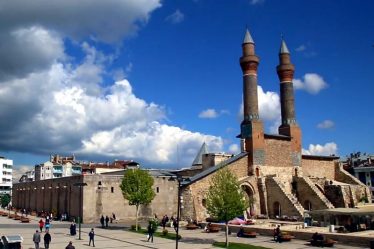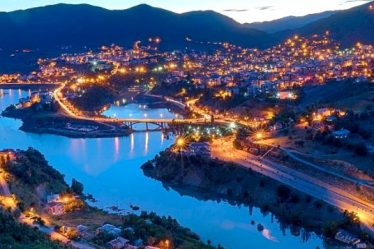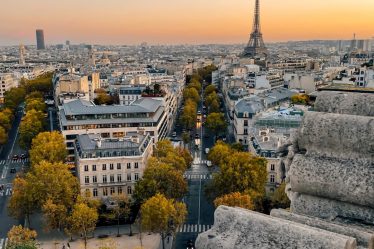Dresden , a charming German city, has been called the Florence of the Elbe River . Impressive monuments, historical buildings and important bridges adorn every corner of Dresden, located in eastern Germany , close to the Czech Republic border. The yellow and pale green facades of the city, which remained within the borders of East Germany until the fall of the Berlin Wall, give a magnificent view and their simplicity makes the atmosphere much more attractive.
Revealing the best examples of the Baroque reign, Dresden has been the capital of Germany’s Saxony State since the 15th century and has hosted Saxon kings for centuries. Many of the city’s dazzling masterpieces date from the time of Augustus and his son, Frederick Augustus II, who lived in the 18th century. The streets of the city, the friendliness of the people, the calmness of the city make you forget that you are in Germany. Combined with Berlin and Leipzig , it could be a great route.

Within the borders of East Germany and II. Dresden, which did not receive a single attack until the last days of World War II, was subjected to one of the most painful war scenes in history in the last days of the war (13-14 February), despite the surrender of Germany. According to German sources, 230,000 people died as a result of the attack, which is known as the Dresden Bombardment in history to avenge the British cities that were bombed by the Allied Powers .
The entire old city was destroyed in the bombardment and Dresden, which is called a fairy tale city, was in ruins. It is now known that this number was given with an extra zero on purpose to shake up the agenda at the time. There are also a few films made on this subject, especially after the fall of the Berlin wall.

Dresden is a city born from the ashes. The city has surprisingly rebuilt its lost monuments over time. Despite heavy damage in the Second World War, the Old Town has preserved or regained its most beautiful structures. Frauenkirche , Zwinger , Semper Opera , Elbe palaces or the Garden City of Hellerau. Dresden is one of Germany’s favorite cities with its historical buildings that will excite you wherever you look. There is still a lot of restoration work in progress in the city.
The most famous viewpoint of the city, Brühl Terrace , is enough to explain why the city is a world class city of culture. At the top of the elegant River Elbe , behind the terrace from which you can catch a glimpse of the bridges adorning the river, is the center of Dresden with its magnificent buildings in the Renaissance, Baroque and Classicism styles.
The city is divided into two as Alstadt and Neustadt by the Elbe River . The magnificent Augustus Bridge connects these two sides. Dresden’s historic center sits elegantly on the left bank of the River Elbe. Renaissance, baroque and 19th century buildings define the character of the city. Altmarkt Square and Prager Street are lined with shops, restaurants, coffee shops and arts centres.

Despite the Kulturpalast (Cultural Palace) next to it, which is not an attractive place at all, the Altmarkt , its giant square shape and the streets surrounding it literally make you say the real center of Dresden. Influenced by the Stalinist era of the 1950s, its colonnaded structures survived the relentless efforts of city planners to turn it into a parking lot.
The rebuilt Rathaus (Town Hall) is located here. The people of Dresden make a lot of jokes about not parking your car here because you may not be able to find your car when you return because it is under constant construction.
Dresden’s extraordinary baroque masterpiece, the Zwinger , known as the Castle Courtyard, is entered from the majestic gate Kronentor. To create this masterpiece, Augustus assembled a small army of artists under the leadership of architect Matthaus Daniel Pöppelmann. The work started in 1707 and was completed in 1728. There are impressive gardens, magnificent pools, fountains and 5 magnificent interconnected mansions in the huge courtyard.

Semperoper , one of the most famous opera houses in Germany , is located on the banks of the Elbe River, in the Theater Square (Theatherplatz). The building, which displays works such as Richard Wagner’s magnificent opera Rienzi, Der Fliegende Hollander and Tannhause and Richard Strauss’s Salome, Elektra and Der Rosenkavalier, has a great cultural significance.
Weber, another artist who worked hard to make Dresden Germany’s music and cultural centre, has a statue in the shadow of Zwinger right outside the opera. Even if you’re not an opera lover, I’m sure you’ll be amazed by Semper’s interior design. Gorgeous colours, perfectly rendered marble and furniture have an air of seduction.

The Frauenkirche Church, built right next to the Elbe river , is yet another baroque architectural masterpiece of the city. It was completed in 1743 as an important component of Dresden’s old town. II. In the bombing of Dresden in World War II, the magnificent walls of the church were completely burned and remained in a pile of rubble for the next 50 years.
On the initiative of Dresden in the early 1990s and with the support of the Saxon Lutheran Church, the Frauenkirche, known as the Women’s Church of Peace, was reopened in 2005, 60 years after it was destroyed in the Second World War. Today, as the most famous symbol of the reconstruction in the city center, it greets the visitors with the splendor of the baroque dome dominating the city.

When the country’s art treasures were distributed to German cities, it seems that it was not very fair. The cultural treasures collected in Dresden are so many that today visitors can be surprised by the splendor of these rich cultural treasures. The Royal Palace Residenzschloss and the Palace Museum, where Saxon treasures and jewels are exhibited, are among the places to visit. The Türckische Cammer (Turkish Room) , an exhibition of Ottoman collections collected by the Saxon dukes for centuries, is worth seeing.
When you move a little further into the city after the palaces, you first come across the Baroque-Roman style Hofkirche , built in 1738 . It is very magnificent with the sculptures adorning the exterior of the Baroque work. The wall painting named The Duke’s Regiment , made of 24000 pieces of porcelain with a length of 102 meters, depicting the stories of 35 Saxon kings who ruled the Saxon dynasty, is among the most spectacular works of Dresden.
The romantic banks of the Elbe River, the peaceful Grosser Garten (Great Garden) and the nearby Sächsische Schweiz (Saxon Switzerland) , which offers unlimited leisure and sports opportunities, are among other attractions among the fifteen largest cities of Germany, residents of the city are here to play sports. It might be a good idea to watch while you do it.

The Elbe Valley, which remained untouched as a border region for both the Federal Germany and the German Democratic Republic, was officially included in the World Cultural Heritage List. However, the Waldschlößchen Bridge, built over the river in central Dresden, caused UNESCO to withdraw the title in 2009. Thus, a UNESCO title was withdrawn for the first time in the category of culture.
Opened in the twenty-fifth year of German reunification, the Elbe Cycle Trail runs along the Elbe River, part of the border between East and West Germany for 40 years. Along the route, which has been the subject of immersive films, cult places such as the Bauhaus in Dessau can be explored, as well as the impressiveness of the environment.


